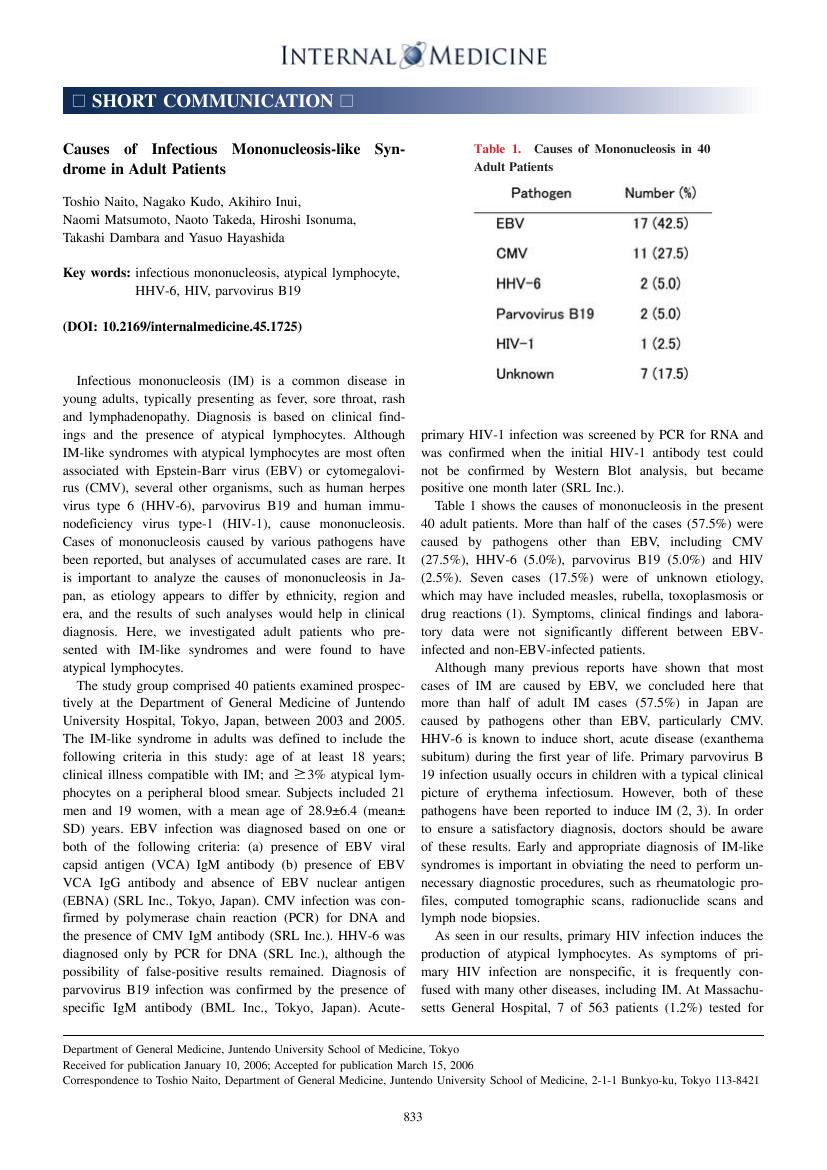- 著者
- Masashi Yamanouchi Yuki Uehara Hirohide Yokokawa Tomohiro Hosoda Yukiko Watanabe Takayoshi Shiga Akihiro Inui Yukiko Otsuki Kazutoshi Fujibayashi Hiroshi Isonuma Toshio Naito
- 出版者
- 一般社団法人 日本内科学会
- 雑誌
- Internal Medicine (ISSN:09182918)
- 巻号頁・発行日
- vol.53, no.21, pp.2471-2475, 2014 (Released:2014-11-01)
- 参考文献数
- 26
- 被引用文献数
- 4 24
Objective The causes of fever of unknown origin (FUO) vary depending on the region and time period. We herein present a study of patients with classic FUO where we investigated differences based on patient background factors, such as age and causative diseases, and changes that have occurred over time. Methods We extracted and analyzed data from the medical records of 256 patients ≥18 years old who met the criteria for classic FUO and were hospitalized between August, 1994 and December, 2012. Results The median age of the patients was 55 years (range: 18-94 years). The cause of FUO was infection in 27.7% of the patients (n=71), non-infectious inflammatory disease (NIID) in 18.4% (47), malignancy in 10.2% (26), other in 14.8% (38), and unknown in 28.9% (74). The most common single cause was human immunodeficiency virus (HIV)/acquired immunodeficiency syndrome (AIDS) (n=17). NIID and malignancy were more common in patients ≥65 years old than in patients <65 years old. During 2004-2012, compared to 1994-2003, infections and "other" causes were decreased, whereas NIID, malignancy, and unknown causes were increased. Conclusion FUO associated with HIV/AIDS is increasing in Japan. In addition, as in previous studies in Japan and overseas, our study showed that the number of patients in whom the cause of FUO remains unknown is increasing and exceeds 20% of all cases. The present study identified diseases that should be considered in the differential diagnosis of FUO, providing useful information for the future diagnosis and treatment of FUO.
- 著者
- Miki Oike Toshio Naito Mizuha Tsukada Yasumi Kikuchi Naoharu Sakamoto Yukiko Otsuki Hiroko Ohshima Hirohide Yokokawa Hiroshi Isonuma Takashi Dambara
- 出版者
- The Japanese Society of Internal Medicine
- 雑誌
- Internal Medicine (ISSN:09182918)
- 巻号頁・発行日
- vol.51, no.10, pp.1259-1263, 2012 (Released:2012-05-15)
- 参考文献数
- 40
- 被引用文献数
- 12 16
Diaphragmatic paralysis is commonly caused by surgical and traumatic injuries, malignant neoplasm, and neurodegenerative disorders. However, in rare instances, diaphragmatic paralysis due to herpes-zoster virus infection has been reported. Here, we describe an 85-year-old woman who developed left hemidiaphragmatic paralysis within 19 days of the appearance of a typical herpes-zoster rash involving the C4-5 dermatome on the left side. Clinical and radiological findings revealed no local causes of phrenic nerve lesion. The hemidiaphragmatic paralysis was thought to be caused by herpes-zoster virus infection.
- 著者
- Kazutoshi Fujibayashi Hiroshi Fukuda Hirohide Yokokawa Tomomi Haniu Fukuko Oka Miki Ooike Toshiaki Gunji Noriko Sasabe Mitsue Okumura Kimiko Iijima Teruhiko Hisaoka Hiroshi Isonuma
- 出版者
- Japan Atherosclerosis Society
- 雑誌
- Journal of Atherosclerosis and Thrombosis (ISSN:13403478)
- 巻号頁・発行日
- vol.19, no.10, pp.932-940, 2012 (Released:2012-10-29)
- 参考文献数
- 42
- 被引用文献数
- 22 28
Aim: The aim was to investigate the respective associations between lifestyle and proteinuria and the estimated glomerular filtration rate (eGFR).Methods: The lifestyle habits of 25,493 middle-aged participants were investigated in a cross-sectional study to find habits that are associated with a low eGFR (<60 mL/min/1.73 m2) and/or the presence of proteinuria. The lifestyle habits of the participants were evaluated using a questionnaire. Unhealthy lifestyle habits were defined as follows: 1. obesity, 2. being a current/former smoker, 3. eating irregular meals, 4. having less than 5 hours sleep, 5. exercising less than once a week, and 6. drinking more than once a week. The associations among unhealthy habits, eGFR, and proteinuria were evaluated using multivariate analysis.Results: The following lifestyle factors were significantly and independently associated with proteinuria: obesity (odds ratio (OR): 1.18, 95%C.I: 1.04-1.34), being a current/former smoker (OR: 1.26, 95%C.I: 1.11-1.42), eating irregular meals (OR: 1.40, 95%C.I: 1.22-1.61), sleeping less than 5 hours (OR: 1.38, 95%C.I: 1.15-1.65), and exercising less than once a week (OR: 1.18, 95%C.I: 1.05-1.33). In contrast, the following unhealthy lifestyle factors were not clearly associated with a low eGFR: obesity (OR: 1.05, 95%C.I: 0.95-1.17), being a current/former smoker (OR: 0.76, 95%C.I: 0.69-0.84), eating irregular meals (OR: 0.91, 95%C.I: 0.79-1.04), sleeping less than 5 hours (OR: 1.02, 95%C.I: 0.85-1.22), and exercising less than once a week (OR: 0.91, 95%C.I: 0.83-0.99).Conclusion: Associations between proteinuria and unhealthy lifestyle habits were observed in our cross-sectional study. Unhealthy lifestyles should be monitored during the management of CKD patients with proteinuria.
- 著者
- Toshio Naito Keiko Kume Kazunori Mitsuhashi Tetsu Okumura Hiroshi Isonuma Takashi Dambara Koichi Suda Yasuo Hayashida
- 出版者
- 日本プライマリ・ケア連合学会
- 雑誌
- General Medicine (ISSN:13460072)
- 巻号頁・発行日
- vol.7, no.1, pp.21-24, 2006 (Released:2010-06-08)
- 参考文献数
- 16
- 被引用文献数
- 1
We recently encountered a case of fatal pneumococcal infection in a previously healthy 19-year-old female. She had no history of splenectomy, but on autopsy she was found to have hyposplenism. It has been widely reported that life-threatening pneumococcal infection can occur after splenectomy, though cases of hyposplenic or asplenic adults, without a history of splenectomy, are very rare. We report this case and review the literature dealing with 6 similar cases.
- 著者
- Toshio Naito Nagako Kudo Akihiro Inui Naomi Matsumoto Naoto Takeda Hiroshi Isonuma Takashi Dambara Yasuo Hayashida
- 出版者
- 一般社団法人 日本内科学会
- 雑誌
- Internal Medicine (ISSN:09182918)
- 巻号頁・発行日
- vol.45, no.13, pp.833-834, 2006 (Released:2006-08-01)
- 参考文献数
- 5
- 被引用文献数
- 9 16 17
